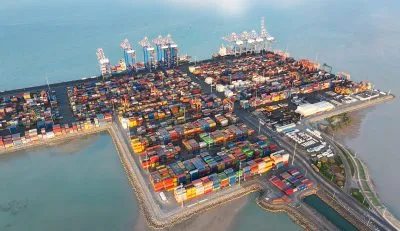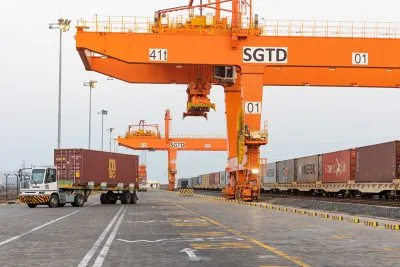Read our full report on Africa’s Top 100 Banks in 2023
Earnings have rebounded while both capital and assets have increased in this year’s survey of Africa’s Top 100 Banks.
Our annual survey ranks Africa’s banks according to their Tier 1 capital. This consists of: capital + reserves + retained earnings + minority interests. These are published in local currencies and then converted into US dollars at the exchange rates at the year-end date in the results (or on 31 December 2021), so changing FX rates can affect the ranking.
We collect the data from Bankers’ Almanac and from the in-house research of African Business. We have excluded some banks where data is old or unreliable.
In the article below, Neil Ford analyses what this year’s figures show. We include a table giving the full ranking of the Top 100 Banks.
The past year has been a time of rapid recovery for Africa’s biggest banks. Revenue and profits were depressed during the height of the Covid-19 pandemic and associated restrictions but a combination of high levels of bank resilience and pro-active support from some central banks helped them cope with the height of the crisis.
Earnings have now rebounded and there has been an increase in both capital (8.7%) and assets (11.3%), while costs are increasingly being brought under control by greater focus on digital banking channels. At the same time, the ongoing process of banking sector integration across the continent should benefit from the steady implementation of the African Continental Free Trade Area (AfCFTA).
Little change at the top
The upper echelons of our table of the Top 100 African Banks this year have a very familiar feel to them. The 15 biggest banks as measured by Tier 1 capital are the same as last year, although there has been some modest movement within the rankings. South Africa’s Standard Bank Group is still the biggest bank in Africa by a considerable distance, with Tier 1 capital of $13.6bn, ahead of National Bank of Egypt with $7.2bn.
The biggest changes at the top of the table are Egypt’s Banque Misr jumping from eighth to third position, with its capital more than doubling between 2019 and 2021 to $7.2bn, and South Africa’s FirstRand moving from sixth to fourth position, with a $1.5bn rise in capital to $6.4bn.
Morocco’s Attijariwafa Bank and South Africa’s Absa Bank make up the rest of the top six. Indeed, the 15 biggest African banks are all based in either North Africa or South Africa at opposite ends of the continent. Attijariwafa and National Bank of Egypt have steadily moved up our rankings over the past decade, breaking up what used to be a solid block of four or even five South African banks at the top of the table.
Modest overall growth
Capital in our table refers to Tier 1 capital: banks’ initial capital, plus reserves and retained earnings, which demonstrates a bank’s overall strength. The column for assets essentially covers the size of their loan book. It should be noted that there is some variation in the date of the most recent results for each bank but we have used the most recent dates wherever possible. No data is available for Libyan banks and so they cannot be included.
Most of the continent’s biggest banks are based in fairly open markets. The only partial exceptions are Banque Extérieure d’Algérie and Banque Nationale d’Algérie. The Algerian market is still more tightly regulated than most, although there are six Algerian banks in our Top 100, indicating strong competition within the domestic market.
There has been modest growth in the sector as a whole, with an 8.7% rise in the combined capital of the Top 100 to $135bn, up from $124bn last year and $101bn in 2019. Assets are growing rather more quickly, with an 11.3% increase from $1.4 trillion in our 2021 survey to $1.6 trillion this year, a significant increase on the $1.2 trillion recorded in 2019 before the pandemic.
Another indication of the sector’s strength in depth is the fact that Arab Tunisian Bank needed $231m in capital to secure 100th position in our rankings, in comparison with the $216m that Gulf Bank Algérie registered last year.
Profits bounce back strongly
Although the revenues of African banks were not as badly affected by the global pandemic as many had feared, profits were somewhat depressed but have bounced back strongly this year.
The combined headline earnings of South Africa’s big four banks increased by 99% in 2021 in comparison with the previous year, largely on the back of decreased rates of non-performing loans (NPLs) but also because of falling costs as a result of digitisation strategies.
Some banks now have lower rates of NPLs than before the pandemic, with Tanzania’s CRDB, for instance, reducing its rate from 8.6% in 2018 to 3% this year. The tougher capital reserve requirements that had been imposed by regulators in some markets over the past decade appear to have made many banks more resilient to the impact of the pandemic.
Regional breakdown
Almost half of our Top 100, a total of 47 entries, come from North Africa, with the region accounting for almost exactly the same proportion of total capital and assets at around 48%. Southern Africa is the next most important region, with 21 entrants, a 32% share of combined capital and 33% of all assets.
West and East Africa are less represented than might be expected, with just 17 and 14 representatives in the Top 100 respectively. Yet as we discuss on page 50, it is Central Africa that is by far the weakest link in the continent’s banking landscape. Continuing to rely heavily on the export of raw materials, the private sector in most other strands of the economy remains limited.
On a national basis, Egypt has the most banks in our Top 100 at 25, far ahead of Nigeria with 12 and Morocco, Kenya and Tunisia, with seven each. Yet although there are only six South African banks in our table, they are all at the top end of the rankings.
There is considerable competition between them in both the retail and corporate markets, highlighting the fact that competition does not require a large number of banks. Indeed, as the experience of the Nigerian banking sector over the past 20 years has demonstrated, it is better to have a smaller number of highly capitalised banks within a competitive regulatory regime than a higher number of lower capitalised banks that are more vulnerable to the vagaries of uncontrollable international economic trends.
There are seven new entrants in the Top 100. Crédit du Maroc returns after a year’s absence at number 49, while six new banks appear in the lower quartile of our ranking, led by Standard Chartered Bank Nigeria in 75th place.
Banque Internationale Arabe de Tunisie (BIAT) is one of the biggest risers, moving up from 50th in last year’s survey to 38th in our 2022 rankings on the back of a $177m increase in Tier 1 capital to $768m. The United Bank of Egypt has moved up 15 places to 55th and Standard Bank Mozambique 14 positions to 66th, while Namibia’s Bank Windhoek rises nine places to 81st.
Islamic finance is continuing to make steady inroads in some parts of the continent. Banque Nationale d’Algérie, for instance, is in the process of opening a dozen branches that will only provide Islamic finance products, while Omdurman National Bank in Sudan is building its Islamic banking operations through digital channels.
In Egypt, where the first bank following Islamic banking principles was launched in 1967, 14 of the 38 licensed banks in the country offer Islamic banking products. Some argue that it enables more money to be invested in more productive sectors of the economy, including agriculture, than mainstream banking because there are restrictions on which sectors can benefit from it.
Ethiopia opens up
Perhaps the most important development in the African banking sector is one that is yet to be felt in our rankings. The government of Ethiopia has finally decided to liberalise its banking industry, opening the sector up to competition from foreign banks. This not only provides a great opportunity for other African banks but could trigger profound changes within established Ethiopian banks so they face competition from banks that have matured in more liberalised markets.
There are currently only two Ethiopian banks in our Top 100: Commercial Bank of Ethiopia in 32nd and Awash International Bank in 91st, a meagre return given that the country’s 121m inhabitants account for 11.5% of the 1.4bn population of Africa and the fact that it boasts the fastest growing economy on the continent over the past decade. However, the tensions between its economic ambitions and high levels of state control should steadily result in the liberalisation of those sectors that remain highly regulated.
Over the past year, Addis Ababa had said that domestic banks should prepare themselves for deregulation and greater competition. It was suggested earlier this year that foreign banks might be required to operate in Ethiopia in partnership with local banks but details of the final deregulation plans are still being finalised in preparation for their publication in December. It remains unclear whether all restrictions on profit repatriation will be lifted but it seems likely that there will be some consolidation among the 24 banks currently operating in the country.
The sector has been closed to foreign banks in order to protect domestic banks and sources within the country suggest that Ethiopian banks have enjoyed a return on equity in excess of 20%, far higher than the global average. Deregulation should make it easier for Ethiopian small and medium sized enterprises (SMEs) to secure access to credit and for Ethiopian firms of all sizes to access hard currency.
It should also prompt local banks to upgrade their technology and embrace digital banking more fully. It will be interesting to see whether the expected influx of foreign banks will see a faster switch to digital banking in a market that is still dominated by large branch networks, with Commercial Bank of Ethiopia operating about 1,300 branches that serve its 22m customers and Awash Bank 566 branches covering 5m customers.
Digitalisation speeds up change
The African banking sector is in the middle of a period of profound flux, particularly as a result of the rapid digitalisation of banking infrastructure and services. Under pressure from the provision of financial services by telecoms companies, digital-first banks and the opportunities offered by fintech more broadly, established African banks are being forced to change the way they do business. Growing access to smartphones and other internet-connected devices allows services to be provided virtually to customers.
The pace of the digital revolution has only speeded up as a result of Covid-19 related restrictions and it is possible that the number of physical bank branches on the continent has already peaked, with Standard Bank in South Africa and Standard Chartered Nigeria, for instance, already closing many of their branches.
Adopting a purely digital approach allows banks to avoid the costs associated with building a branch network, while avoiding IT legacy challenges. Digital technology has already turned sub-Saharan Africa into the second fastest growing regional banking market in the world, as well as the second most profitable.
With the number of physical branches operated by a bank becoming a less accurate indicator of the size of any particular bank, it will be interesting to see how long it will take the first digital-first bank to enter our Top 100. They are growing more quickly than their more traditional counterparts, with Bettr and TymeBank, both of South Africa, plus Nigeria’s Chipper Cash, the largest as measured by customer base with 6.5m, 4m and 4m customers respectively.
Barriers remain in terms of the advantages that traditional banks retain in utilising their established brands while building new digital platforms, limitations on customer IT hardware and literacy, and the failure of some central banks and other regulators to create a conducive environment for digital banking because they fear that rapid change will allow unstable banking practices to emerge. Tackling the latter obstacle will require a change in banking culture as much as anything else.
At the same time, the digital revolution is encouraging all financial services providers to drive up banking penetration rates. Where once many focused solely on serving high net worth individuals and large corporations, the lure of the mass market and attracting SME customers is being driven by the lower operating costs afforded by digital platforms. Yet there is still a tendency for African banks to buy government bonds rather than lending more to the “real” economy, particularly through corporate and SME lending.
Want to continue reading? Subscribe today.
You've read all your free articles for this month! Subscribe now to enjoy full access to our content.
Digital Monthly
£8.00 / month
Receive full unlimited access to our articles, opinions, podcasts and more.
Digital Yearly
£70.00 / year
Our best value offer - save £26 and gain access to all of our digital content for an entire year!
 Sign in with Google
Sign in with Google 



